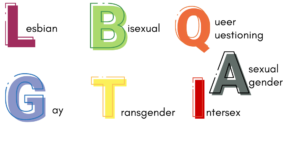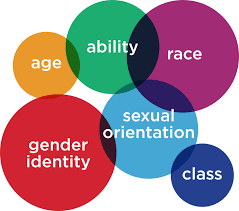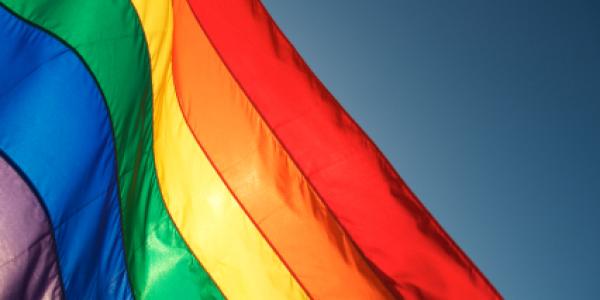In today’s increasingly diverse world, understanding, accepting, and advocating for the rights and experiences of different communities has become critical. One such community is the Lesbian, Gay, Bisexual, Transgender, Queer, or Questioning (LGBTQ+) community. This blog aims to provide insight into LGBTQ issues faced by individuals and their journey toward acceptance and equality. And the significant issues that still need to be addressed. It is an exploration that we hope will encourage readers to approach these topics with an open mind, compassion, and the motivation to advocate for change.
Contents
Understanding LGBTQ+
 The LGBTQ+ community is a broad, diverse group that includes anyone who identifies as lesbian, gay, bisexual, transgender, or queer/questioning. And the plus (+) signifies a range of other sexual orientations and gender identities, including but not limited to asexual, intersex, and pansexual individuals. These terms are all about expressing the truth of one’s own self-identification in terms of sexual attraction and gender identity.
The LGBTQ+ community is a broad, diverse group that includes anyone who identifies as lesbian, gay, bisexual, transgender, or queer/questioning. And the plus (+) signifies a range of other sexual orientations and gender identities, including but not limited to asexual, intersex, and pansexual individuals. These terms are all about expressing the truth of one’s own self-identification in terms of sexual attraction and gender identity.
It’s important to note that sexual orientation, which pertains to whom one is attracted to, and gender identity, concerning one’s personal sense of their own gender, can be fluid and fall along a spectrum. That means they are not limited to binary categories. Understanding the LGBTQ+ community also involves acknowledging the unique experiences and challenges faced by its members.
What Are Some Common LGBTQ Issues?
The following are some common LGBTQ issues that you must know:
Discrimination and Stigma
Discrimination against the LGBTQ+ community can manifest in numerous ways. Including verbal and physical harassment, rejection from family and peers, workplace discrimination, and unequal treatment in educational, healthcare, and other public settings. The root of such discrimination often lies in societal stigma and prejudiced attitudes towards people with diverse sexual orientations and gender identities.
These biases can be perpetuated by negative stereotypes, lack of awareness or understanding, and intolerance. The impacts of this discrimination can be profound, affecting the mental and physical health of LGBTQ+ individuals, and limiting their opportunities. And diminishing their quality of life.
Legal Inequality
Despite progress in many areas, LGBTQ+ rights are far from uniform worldwide. For instance, homosexuality is still considered a criminal offense in some countries, punishable by imprisonment or even death. In others, while homosexuality may be legal. Still, same-sex marriage or civil partnerships are not recognized. And denying same-sex couples the same legal protections and benefits as their heterosexual counterparts.
Additionally, even in countries with more progressive LGBTQ+ rights, laws often fall short of protecting against discrimination in areas. Such as employment, housing, healthcare, and education. Transgender individuals may face legal hurdles in obtaining identification documents that reflect their gender identity. Eventually, impacting their access to various services and rights.
Health Disparities
 The LGBTQ+ community tends to experience various health disparities compared to the heterosexual and cisgender populations. Due to the high levels of stress from social stigma and discrimination, LGBTQ+ individuals are at an elevated risk for mental health issues, including depression, anxiety, and suicide. Substance abuse is also higher within the community, often used as a coping mechanism.
The LGBTQ+ community tends to experience various health disparities compared to the heterosexual and cisgender populations. Due to the high levels of stress from social stigma and discrimination, LGBTQ+ individuals are at an elevated risk for mental health issues, including depression, anxiety, and suicide. Substance abuse is also higher within the community, often used as a coping mechanism.
LGBTQ+ individuals may face hurdles in accessing appropriate healthcare services due to factors. Such as discrimination from healthcare providers, fear of being out, and a lack of providers trained in LGBTQ+ health needs.
Violence
Hate crimes against the LGBTQ+ community are a pervasive issue, with many such crimes being violent and sometimes lethal. This violence may be motivated by homophobia, biphobia, or transphobia. Beyond hate crimes, LGBTQ+ individuals, particularly those who are transgender, face high rates of intimate partner violence. Cyberbullying and online harassment targeting LGBTQ+ individuals, especially youth, have also become increasingly common.
Conversion Therapy
Conversion therapy, also known as reparative therapy, is a set of practices aimed at changing an individual’s sexual orientation or gender identity. That is based on the premise that being LGBTQ+ is a mental disorder that can be ‘cured’. These practices, however, have been widely discredited. And also, condemned by major medical and psychiatric organizations due to their potential for causing harm. Conversion therapy is associated with adverse outcomes such as depression, anxiety, social isolation, and suicidality. While some countries and regions have enacted laws banning conversion therapy, it still exists in many parts of the world.
Lack of Representation
Representation of LGBTQ+ individuals in media, politics, business, and other public spheres remains limited. This lack of representation has several implications. It can perpetuate harmful stereotypes by not providing accurate or diverse depictions of the LGBTQ+ community. In politics and decision-making roles, the underrepresentation of LGBTQ+ individuals can lead to policies that overlook the community’s specific needs.
For LGBTQ+ youth, seeing themselves reflected in the media or in positions of influence can be pivotal for their self-acceptance and confidence. Hence, better representation across all sectors of society is important for promoting equality and understanding.
Youth Homelessness
Studies indicate that a disproportionate number of homeless youth identify as LGBTQ+. This is often the result of familial rejection due to their sexual orientation or gender identity. Eventually, leading these individuals to flee or be expelled from their homes. Once on the streets, LGBTQ+ youth are more vulnerable to a range of threats, including physical and sexual violence, mental health issues, and substance abuse. Additionally, they often face barriers to services such as emergency shelters, which may not be equipped or willing to accommodate the specific needs of LGBTQ+ youth.
Transgender Rights
Transgender individuals, those whose gender identity differs from the sex they were assigned at birth, face a unique set of challenges. Legally, they may struggle to obtain recognition of their gender identity on official documents, impacting everything from their ability to access healthcare to their security when using identity documents that do not match their gender presentation. In healthcare, transgender individuals often face discrimination and a lack of knowledgeable providers, making access to vital services like hormone therapy or gender-affirming surgeries difficult. Transgender people also experience disproportionately high rates of violence and discrimination in many areas of life, including employment, education, and housing.
Intersectionality
Intersectionality refers to the interconnected nature of social categories such as race, class, and gender. That can create overlapping and interdependent systems of discrimination or disadvantage. For LGBTQ+ individuals who belong to other marginalized groups, these effects can be compounded. For example, a person who identifies as transgender and is also a member of a racial minority group may face not just transphobia, but also racism. And these forms of LGBTQ issues can interact in complex ways. The concept of intersectionality is critical for fully understanding and addressing the diverse experiences within the LGBTQ+ community.
Overall, LGBTQ issues are multifaceted and deeply ingrained in various aspects of society. By recognizing and understanding these LGBTQ issues, we can all contribute to creating a more inclusive, supportive, and equal world. It is incumbent upon each of us, regardless of our own identities, to stand against discrimination, and support those in our communities who are often marginalized and misunderstood.
How To Deal With These LGBTQ Issues?
 Addressing LGBTQ issues requires action on multiple fronts. Here are some strategies that can help:
Addressing LGBTQ issues requires action on multiple fronts. Here are some strategies that can help:
- Promote and Support Legal Protections
Advocacy for legislation that protects the rights of LGBTQ+ individuals is crucial. This includes laws that prohibit discrimination in areas such as employment, housing, education, and healthcare. As well as laws that recognize the rights of same-sex couples and transgender individuals. In areas where such laws exist, it’s important to ensure they are adequately enforced.
- Educate the Public
Public attitudes are a significant factor in the issues faced by the LGBTQ+ community. Efforts to educate the public about the realities of LGBTQ+ lives can help to challenge stereotypes and combat prejudice. This can involve everything from inclusive sex education in schools to media campaigns that raise awareness.
- Support LGBTQ+ Youth
Special attention should be given to supporting LGBTQ+ youth, who are particularly vulnerable to discrimination and its effects. This can involve initiatives like supporting Gay-Straight Alliances in schools, creating safe spaces and resources for LGBTQ+ youth, and providing training to teachers and school staff to better support these students.
- Improve Healthcare Provision
Training for healthcare providers can ensure they are equipped to provide appropriate care to LGBTQ+ individuals. At the same time, policy changes can ensure that healthcare systems are inclusive and responsive to the needs of this community. Mental health support should also be a focus, given the high rates of mental health issues within the LGBTQ+ community.
- Promote Representation
Increasing the representation of LGBTQ+ individuals in media, politics, and other sectors can challenge stereotypes. And ensure that the needs of this community are considered in decision-making processes.
- Provide Support Services
Support services, such as counseling, support groups, and crisis lines, can provide essential help to LGBTQ+ individuals who are dealing with discrimination or other difficulties. These services should be inclusive, accessible, and sensitive to the specific needs of the LGBTQ+ community.
- Foster Open Conversations
Promoting open, respectful conversations about sexual orientation and gender identity can foster understanding and acceptance within families, workplaces, schools, and communities.
Remember, change is a collective responsibility and everyone has a role to play. Whether through advocacy, education or simply showing support and understanding, we can all contribute to improving the lives of LGBTQ+ individuals.
Conclusion
In conclusion, acknowledging and understanding the LGBTQ issues community is the first step toward fostering a more inclusive and accepting society. From legal hurdles to health disparities, violence, and representation issues, these concerns call for immediate action and change. Through proactive advocacy, informed legislation, education, and compassionate conversations, we can contribute towards mitigating these challenges.
Our collective efforts can and will pave the way for a world that respects and celebrates diversity in all its forms. A world where everyone – including those who identify as LGBTQ+ – has the freedom to express their identity without fear of discrimination or prejudice. Because ultimately, it’s not just about tolerance. In fact, it’s about acceptance, understanding, and above all, love.
Life may sometimes be challenging for people from LGBTQ community, but Online LGBTQ Counseling can help. Get experienced LGBTQ therapists at PrideMantra: Book a trial LGBTQ therapy session


